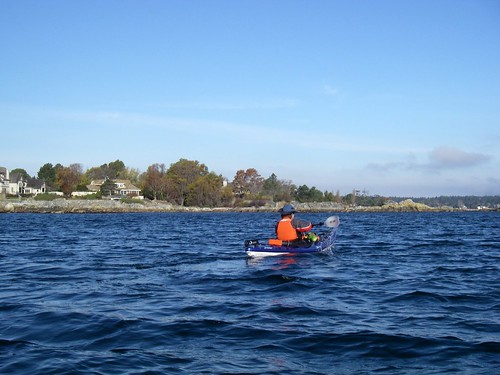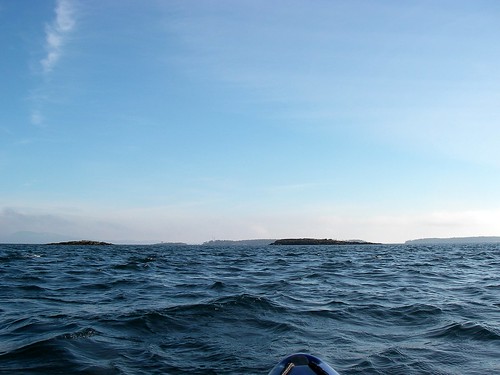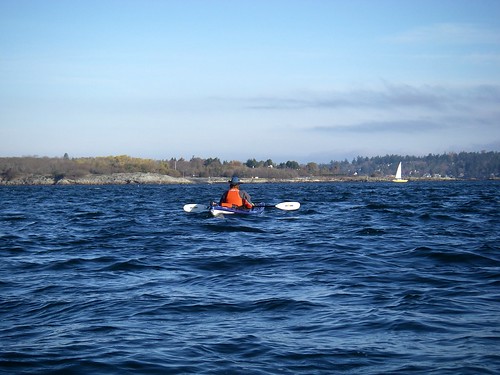Louise and I were able to paddle today and we headed to Willows Beach.

While we still had a beautiful day....

...we didn't get the flat water that Alison and Paula had yesterday.

I'd hope to go out to some of the islands, maybe the Chain group, and try out my new camera on the birds and seals out there. But it was not to be as the wind was up and Louise's stomach was doing the heebie-jeebies. (That is a real technical medical term, by the way.)

So we stuck close to shore and we paddled towards Cadboro Bay. Here a cormorant keeps watch over us.

Even close to shore, the winds were kicking up some waves....

...but on the way back, the wind died off for a few minutes and we enjoyed some of the calm water that we missed yesterday.

Like these fellows, we enjoyed a fine couple of hours on the water.

John's photos are here.

Hi Yak,
ReplyDeleteI've noticed in several of your photos that wet coast paddlers tend to store on the aft deck a closed-cell foam paddle float for paddle-float re-entries.
I'm curious why that seems to be the trend.
Here in New England, paddlers use inflatable paddle floats and typically store them in the cockpit, wedged in between the thigh brace and the hull.
What's the reason, you think, for the popularity of closed-cell foam floats out your way?
Adam
Hi Adam
ReplyDeleteIt's bloody cold in the water!
The thought is that if you end up in the drink, you want to spend as little time as possible exposed to the cold Pacific Ocean. Clearly with a foam paddle float, you have a distinct time advantage over an inflatable paddle float.
I've used both and I think you get more buoyancy with an inflatable, but the foam float does the job, too.
Adam, one marketing reason for people buying closed cell foam paddle floats is that Northern Waters makes such great ones, and it's a local company.
ReplyDeleteBut that's only marketing.
As John says, it's bloody cold in the water. About 7-9 celsius year round.
If I ever need a paddle float, it's probably going to be when the water is rough. The last thing I want to PLAN to do when up to my chin in chop is rootle about inside my cockpit to find an inflatable float and try to blow it up when I'm up to my chin in the saltchuck.
If I had an inflatable paddle float, I'd inflate it and bungee it to my back deck at the beginning of the outing.
Hi John and Paula,
ReplyDeletethanks for the info.
Here on the East Coast (New England) water temps range from 50F to 72 during the warmer months and from the low 30'sF to sea water freezing temps. during winter.
That said, I'm trying to get a grasp of N'west Pacific paddling practices.
Even though almost all of use carry them, I can't remember the last time I saw a paddle float deployed in New England.
The area's core paddling groups (nspn.org, wtpaddlers.org, connyak.org and ricka.org) devote almost fanatical amounts of time to practicing T, H, scoop and bow rescues.
Also most paddlers wear goretex drysuits during the cold water months, with lots of fleece insulation beneath.
Is it (drills and dress)the same or different out your way?
Hate to pester with detailed questions, but different regions favor different habits, and it's always good to know who does what.
Adam
Hi Adam
ReplyDeleteUntil you mentioned it, I hadn't even thought about what the actual water temperature was out here, other than cold of course. (How did we ever survive before Google?)
The water temperature around Victoria stays around 10C (50F) all year. It rarely gets cold enough to freeze (although that is not unknown).
Expensive Gore-tex dry suits are the clothing of choice, and that's certainly something I would want to get in the future. Currently my winter weather wear is a wet suit with a paddling jacket top. Most of our little gang are wearing some combination of neoprene, fleece and paddling jackets at this time of the year.
Frankly, I don't think our little group practise rescues enough or enough rescue techniques, but when we do the T is the favourite. I'd like to practise others like the Scoop as last year I destroyed my shoulder in a big accident (look under The Big Ouch label on the blog for my xrays) and am at a slightly greater risk than average of dislocating my arm again.
Hope this helps!
Interesting commentary on regional clothing. My dream gear is a dry suit. For now it is wetsuit, fleece and paddle jacket. Paula forgot to mention merino wool is a big item here too. Icebreaker makes merino wool clothing and it sells very well here.
ReplyDeleteClothing? I wear a short-sleeve, short-leg wetsuit with merino wool longjohns over (hiding a mended seam in the wetsuit) and merino wool sweater. Paddle jacket over the sweater when there's wind or ANY chance of a flip.
ReplyDeletePlan is to buy drypants & wear 'em over the shortie wetsuit with the paddle jacket.
In our group, we each have different reactions to the possibility of a flip. John's the only one who tipped over out on the ocean. He's got to guard against a shoulder dislocation.
Louise really, really doesn't want to get cold, etc.
I'm really, really afraid that my absent inner ear functions = inevitable flip when my guard is down.
Bernie used to just yell "yarr!" and laugh at rough water but last month he scared himself in the freight train and now he has a little more perspective.
As for us all needing more practise, hey, let's get some this month, both in the bay and later, when Louise finishes her course, in the pool. Yarr!
Man this sport is fascinating. For my noob perspective, when I took lessons in august, I used a blow up float hidden just under the thigh braces just below my left hand. It seemed easy to deal with: first, because you knew where it was - it didn't decide to float on the blind side of the boat (like the bag one I used at the pool loved to do) and second you could use it to do a roll without even knowing any roll skills except to get back in the boat, put your paddle on the surface and twist, but that was at thetis lake, a tepid bathtub. I can see how things might get a little hairy half way through a difficult channel crossing, though - you'd probably be pretty damned peeved to aspirate into air matresses around your paddle at that point. The rolling over part seemed much harder with a closed cell bag when I tried it at the pool - I could just get enough momentum to lose support and go back under. To me it just says I should take a rolling class and leave the damned float out of it.
ReplyDeleteI do notice one thing though: it seems when teaching kayaking, everyone - and I mean everyone - has a habitual manner of doing things and they tend to pontificate wildly even if it's not all that different from an alternate method of getting the same results. Our training course had two instructors and they bickered about protocol on everything from what to use your paddle jacket (tucked in, tucked out over your pfd under your pfd around your neck around your scalp...) to what manner of paddle feathering they preferred to what weather monitoring equipment to deal with. It makes a novice dizzy.
One day, I hope I'll be sipping fine teas and discussing the finer details of what crap people strap to their boat/thigh braces and how much that 10 degree feather has saved/destroyed my arms after 10 years of paddling thousands of kilometers. :)
Hi John,
ReplyDeletethanks again. Another rescue that sometimes gets used out here is the rat swim. Essentially it's a way to get as many breaths of air as you might want after a capsize, yet without having to wet exit.
I wrote about the rat swim in the recent issue of WaveLength Magazine and on my blog.
Sorry to hear about your shoulder.
GoreTex drysuits are expensive, but now that the patent exclusive seems to have expired, companies like NRS have come out with breathable watertight fabrics that cost a lot less.
Adam
Hey Adam
ReplyDeleteI read that article in Wavelength, I enjoyed it. I've been wanting to try that....
I've got a video of the rat swim that I'll be posting soon on Youtube.
ReplyDeleteJohn, you might want to be careful with the rat swim if you have a bad shoulder. The technique requires a lot of arm and shoulder rotation: essentially you use your arms to tread water so you can lift your head and toros to breath.
So if that motion could strain your shoulder socket and ligaments, I'd try treading water in a pool first, without the boat, just to see how the motion feels.
I'd hate to see a technique that I've written about lead to an injury.
Adam
paddlingtravelers.blogspot.com
Thanks for the tip, Adam.
ReplyDeleteActually, I've practised a few self-rescues since getting back on the water and done them with no problem, including treading water so I should be okay. But obiously, I will try it gently at first! :)
Richard, I have to agree with the comments about the amount of sheer noise that new paddlers have to put up with. I very quickly developed a philosophy that when it comes to gear and such, the only question is "does it get you out on the water?" If the answer is yes, then it's an important piece of gear. If not, ignore it. Safety gear is exempt from this--there's the Coast Guard requirements and then there's what you feel you need to be safe in the conditions you paddle in.
ReplyDeleteWhen it comes to paddle or recovery techniques, I figure, learn 'em all, and discard the ones that don't feel right to you. You very quickly figure out what you need to know: a self-recovery or three, an assisted recovery or three, and how to brace so you don't need either of the recovery techniques. Practicing tells you if you're wearing your gear properly--is your PFD up around your ears? Is water pouring into your clothes or just seeping? Getting wet tells you a lot.
It doesn't take long until you become just as opinionated as the rest of 'em, believe me. I'm sure Adam has run into people who think that the rat swim is the stupidest thing they've ever heard of, and can give reason after reason for that opinion. It might even be
I agree with Bernie (well, he's my partner as well as my paddle partner) on the "does it get you out on the water?" line and also on the idea of learning and doing.
ReplyDeleteSaw your rat swim article, Adam. Got me thinking about trying it, maybe during pool practise rather than during wet exit practise in the bay.
Richard, what you're describing doing with a paddle float is using it to assist you in a roll. Neat idea, that you can keep coordinated while upside-down underwater. Doug Alderson describes doing that, for practise only, not during a roll in an actual upset.
What we use paddle floats for is to make an outrigger of a paddle.After a wet exit, the paddler slips the float onto one blade and tucks the empty blade under bungees on the back deck. Then the paddler lays flat on the surface, props one foot on the outrigger (to discourage the tendency for legs to drop down) and crawls onto the back deck and slithers into the cockpit.
Can be done alone but is much more fun if someone is nearby with a camera.
heheh yeah. The fake roll was labelled party trick by my instructors, but apparently a good way to learn the hip snap without a deck or doockside handy..
ReplyDeleteOf course, being a certified training course, we were required to do the "proper" solo paddle float rescue a few times too.. I did a few great "paddle rainbows" (imagine the bright orange float flipping up and over to the other side of the kayak and me ending up back in the water embarassed) before I realized facing the outrigger and keeping my damned hands on the paddle make it a whole lot easier.
I was also paddling a tsunami 145 which has perhaps the worlds largest seat back *sigh*. That made for some good chuckles in the group. I'm glad there was no camera around during that..
I'm definitely trying the rat swim next pool session. That sounds like something great to add to practice.